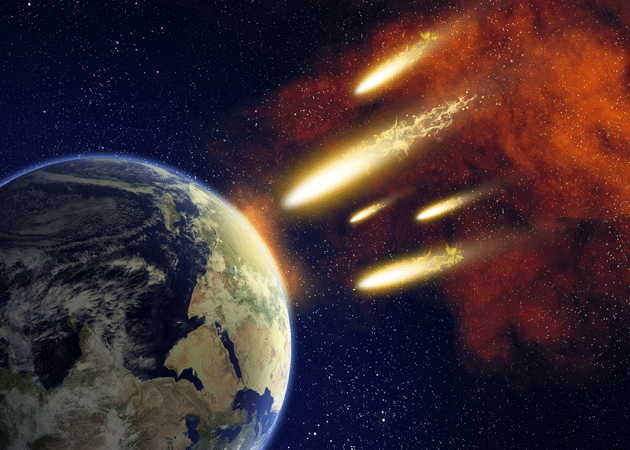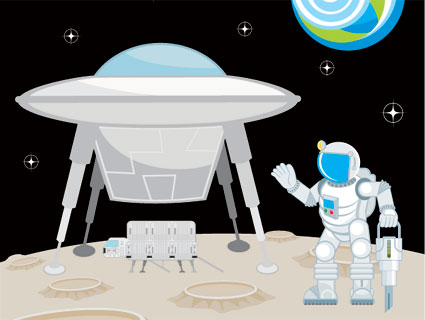
Something we'd like to avoid.<a href="http://www.shutterstock.com">buradaki </a>/Shutterstock
If you believe the folks at NASA—and really, why shouldn’t you?—it’s only a matter of when, not if, we need someone like Dr. Bong Wie to save the human race from a civilization-destroying catastrophe.
Wie is the director of the Asteroid Deflection Research Center at Iowa State University, the only institution in the United States dedicated to the deflection of what NASA calls Near-Earth Objects (NEOs)—”asteroids” to the rest of us. He’s been busy lately. On Friday, Americans woke up to reports and videos of the largest meteorite in more than a century crashing into Siberia. In the late afternoon, 600,000 people watched online as the DA14 asteroid passed just 17,000 miles from Earth. In response to all of this, Rep. Lamar Smith (R-Texas), chairman of the House Committee on Science, Space, and Technology, announced he would hold a hearing “to develop contingencies” in the event of an imminent threat from outer space.
Scientists have been calling on the government to wake up to the NEO threat for decades, “but nothing happened,” Wie says. “We are very lucky to have today’s events.”
Wie’s plan for destroying an Earth-bound asteroid is simple: Stick a massive nuclear device into it and blast it to smithereens. Notwithstanding the 168 factual inaccuracies NASA engineers have reportedly found in Armageddon, Bruce Willis and Billy Bob Thornton got it essentially right. “Astronauts will not be required, so clearly this would be an unmanned robotic mission—but we will need a nuclear device,” Wie says.
The key is, as Jerry Bruckheimer surmised, to drill beneath the surface of the asteroid. If the nuclear device explodes upon impact, it wouldn’t pack enough force to knock the asteroid off its collision course with us. And if the device hits the asteroid at too high a velocity—anything above 300 meters per second—it will simply disintegrate. Wie’s idea is to build a rocket that splits in two just before impact. The front end thereby acts as a blocker, plowing into the asteroid and forming a crater, which the nuclear device then drops into.
“Basically the whole thing was correctly described in the movie,” he says. And Wie isn’t the only nonfictional scientist with this idea; David Dearborn, a nuclear weapons designer at California’s Lawrence Livermore National Laboratory, has long been a proponent of using nukes to blast so-called “Earth-Killer” objects.
Wie estimates the project would take about 5 to 10 years to put together. But “as a worst-case I think we could handle two years—maybe one year.” In contrast, the handful of non-nuclear alternatives NASA has drawn up require much longer lead times—a luxury, considering there was just one year of advance notice before DA14 flew by. The “Asteroid Tug,” which functions like a deep-space tugboat, would require about 50 years to complete its mission. A “Gravity Tractor,” which would hover over the asteroid and (hopefully) lure it off-course with its gravitational force, would need 20 to 30. Other options, including a gigantic mirror and a laser beam to “boil” the surface of an asteroid, are similarly time-consuming.
In the fight against NEOs, the biggest obstacle so far hasn’t come from the cosmos; it’s been in Washington. NASA’s focus has largely been on spaceflight and exploration—not protecting the planet. It wasn’t until President Obama ended NASA’s lunar-driven model in 2009 that the agency finally began turning its attention seriously to NEOs, unveiling a new plan to land a vehicle on an asteroid by 2027. (To his credit, Newt Gingrich did predict we’d build a colony on an asteroid by 2100.) Even now, NASA spends just 0.2 percent of its budget on asteroid research; Wie has received $600,000 in grants.
Up until now, Wie and his colleagues have had few friends in Congress. Rep. Dana Rohrabacher (R-Calif.) has been their biggest booster, pushing for a $40 million program to research and defend against NEO collisions. That effort was unsuccessful, although it did succeed in creating a task force to study the issue. (It doesn’t much help that the asteroid-defense lobby, as the Center for Public Integrity’s Dave Levinthal reports, is a bit of a work-in-progress.)
Still, despite the lack of focus and resources—Wie’s “center,” by his own admission, exists mostly in cyberspace—he says the end isn’t nigh. “We do have all the technology,” Wie says. “We just need a budget for a first-flight demo, which will cost about $500 million, and then you develop the missile.”
After all, he says, when you’re trying to head off an existential threat to mankind, “Don’t you want to have a practice shot?”














